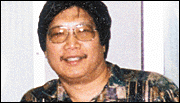

![]()
View Point


![]()
View Point
LAST summer the public sent a clear message to the University of Hawaii Board of Regents: Don't approve a new master plan that allows further development of Mauna Kea and restricts public access to the summit. Mauna Kea is
being threatenedAfter hearing impassioned pleas from Hawaiians, Big Island residents and others across the state, the regents postponed approval until the university's contract planners, Group 70 International, could put together a more responsible proposal.
Now draft three of the plan is finished, but it's virtually identical to the one everybody complained about last summer. Yet the regents are scheduled to approve this plan this month.
Key elements of the plan still haven't changed, including:
The largest development in the history of Mauna Kea, including as many as 58 new telescopes and enlargement of up to five existing facilities.
An almost 10-fold increase in the summit acreage disturbed for astronomy -- from 60 to almost 600 acres.
The first-ever restrictions on public access to the summit, including limiting summit hours, a new ranger-manned "control point" at Hale Pohaku to register visitors (and perhaps collect entrance fees), and the immediate prohibition of two-wheel-drive vehicles above Hale Pohaku with the likelihood of prohibiting all private vehicles once a shuttle system (with fees) is established.
Continued Manoa-based UH Institute for Astronomy review and approval of telescopes, despite establishment of a new UH-Hilo Office of Mauna Kea Management.
Creation of a new Mauna Kea advisory board to advise the UH-Hilo chancellor, made up largely of institutional "stakeholders" like the Institute for Astronomy, state Department of Land and Natural Resources and Hawaii County's mayor and council.
Meanwhile, many community proposals were ignored by the UH-paid consultant, including:
Pleas by Hawaiians and others that no further telescope development be allowed.
The Sierra Club's proposal for a five-year, $1.2-million sublease impact fee for each observatory to pay for the mountain's management, visitor programs, educational outreach and compensation to Hawaiians for use of ceded lands.
Ka Lahui Hawaii's proposal to establish a new commission, not unlike the Office of Hawaiian Affairs, to manage the mountain, in which UH and DLNR would participate but not dominate.
Proposals by some critics to condemn and dismantle the Smithsonian Institution's huge antenna array and the Very Long Based Array antenna. Current construction of the Smithsonian has been targeted in part because of its violations of federal environmental and cultural protection laws.
PARTICULARLY discouraging is Group 70's continued use of misleading and distorted information, such as rewriting the early development history to understate past public opposition, distorting the findings of some cultural and biological studies, and using euphemisms like "recycled sites" to mask the impact of replacing smaller existing observatories with huge facilities.
The UH Board of Regents is scheduled to approve the proposed plan at its Nov. 18-19 meetings in Hilo. Twice before, it has postponed action because of public concern.
Now we hope that the regents will reject the plan outright and call for a new process and planning consultant.
To do otherwise will only further divide the Big Island community and add to the university's current public credibility problems, to say nothing of ruining the mountain.
Nelson Ho lives in Hilo at the foot of Mauna Kea and
serves as conservation chairman of Sierra Club's Hawaii Chapter.